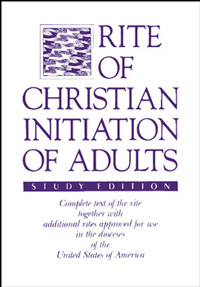 by Kathy Kuczka
by Kathy Kuczka
Growing up in Western Pennsylvania, we spent many summer vacations traveling to visit relatives in New York. Uncle Frank was always the one at the wheel. He made sure we were up way before the crack of dawn so that we could get an early start. For the life of me, I couldn’t figure out why in the world we had to leave so early. We were on vacation after all, and as far as I was concerned, we didn’t have to be in New York at any time in particular. But according to Uncle Frank, “We have to make good time.”
There is a little Uncle Frank in all of us. We want to get to our destination as quickly as possible. We have become so driven toward destiny that we have forgotten how to enjoy the journey.
The document by the U. S. Bishops that guides us as we minister to those who seek to become Catholic, The Rite of Christian Initiation of Adults, is all about journey. From the opening paragraph, the Rite of Christian Initiation of Adults tells us that the process is a spiritual journey of adults “who consciously and freely seek the living God and enter the way of faith and conversion as the Holy Spirit opens their hearts.” (no. 1).
Right from the start we discover that it isn’t we who do the converting, but rather God who opens hearts and sows the seeds of conversion in God’s own time.
The Rite of Christian Initiation of Adults challenges us to look at the journey of conversion in new ways. The focus is not on how much one needs to know, but on who one needs to know, namely the person of Jesus. In this sense, the process of conversion envisioned by the RCIA can be likened to falling in love. Falling in love is a gradual process of conversion marked by various thresholds in the relationship. In the same way, the RCIA is a gradual process of coming to know and to fall in love with God, a process that will vary from person to person.
The road map for this process is the Rite of Christian Initiation of Adults. In order to understand the process, we must read the Rite of Christian Initiation of Adults re-read it, and read it again and again. Don’t be afraid to mark up your copy in a way that will help you sift through it. You can even purchase special tabs for easy reference! Underline words or phrases that stand out, make notes in the margins, tabulate the rituals or other sections that you may need to refer to quickly and easily.
The table of contents gives us the framework for the process. Part one is designed for unbaptized adults and it is this part that gives us the vision for the Rite. Part one includes periods and steps that ultimately lead to the sacraments of initiation, but each of these periods and steps has their own focus.
The first period, that of Evangelization and the Precatechumenate, focuses on evangelization. In this initial period, those who are seeking faith may hear the word of God proclaimed and see it witnessed in the faith community (#36-37). This period ends with the ritual of the Acceptance into the Order of Catechumens, in which inquirers publicly respond to hearing and witnessing the word of God. This step leads to the second period, that of the Catechumenate. This period is shaped by the understanding that one comes to know God better by encountering him in the life of the Christian community and in the word of God (see #75). The rites of this period include liturgies of the Word of God, minor exorcisms, blessings, and anointings, all of which express and celebrate the catechumen’s growth in faith (see #90-105). This period ends with the second step, the Rite of Election, in which the Church acknowledges the decisions of the catechumen to continue their journey towards initiation (see #119-120).
The focus of the period of Purification and Enlightenment is that repentance and conversion of heart help to “enlighten the minds and hearts of the elect with a deeper knowledge of Christ the Savior” (#139). During this period, the three Scrutinies help to “complete the conversion of the elect and deepen their resolve to hold fast to Christ” (#141) through Scripture readings and prayers.
The final step is the celebration of the sacraments of initiation which takes place, most appropriately, at the Easter Vigil. The journey of coming to faith culminates in these sacramental celebrations when the elect are fully initiated into the Paschal Mystery and the life of the Church. Though this is the culminating step, the journey doesn’t end but continues with the period of Mystagogy or Postbaptismal Catechesis during which the neophytes continue to deepen their understanding of the mystery of God and are immersed into the community of believers (see #244-246).
Part two of the table of contents offers guidance for persons in various circumstances, such as unbaptized children who have reached the age of reason (Part II.1), persons who are in danger of death (Part II.2), those baptized in the Catholic faith or in another Christian faith tradition but who have not had any further faith formation (Part II.4), and those who have been baptized in another faith tradition and are ready to be received into the full communion of the Catholic Church (Part II.5).
Following part two are the appendices. Appendix 1 provides the outlines and the texts for ritual celebrations that include both the unbaptized and the baptized. Appendix II offers acclamations, hymns and songs that can be used throughout the process. And finally Appendix III presents statutes for the process of initiation written by the Bishops of the United States for the Church in the U.S. The statutes also include sections from the Code of Canon Law having to do with initiation. These statues are important and should be read and re-read along with the Rite itself.
For those who work in the ministry of initiation, the Rite of Christian Initiation of Adults can be overwhelming. Perhaps that’s because God’s grace is overwhelming. We would do well to remember that the Rite of Christian Initiation of Adults is a journey for all of us, not just the catechumens. To walk with others on this journey is to witness the grace of God unfolding before our very eyes. What a sight to behold!
